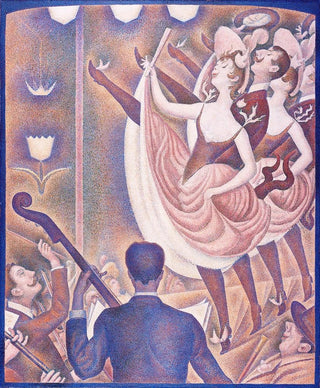Art print | The Chahut - Georges Seurat


View from behind

Frame (optional)
Georges Seurat's iconic artwork, "Le Chahut," offers a captivating glimpse into the vibrant life of Paris at the end of the 19th century. Created in 1889, this painting captures a lively celebration where dance and music intertwine in an atmosphere of joy and camaraderie. The scene unfolds in a cabaret, a popular gathering place for artists and intellectuals of the era. With his revolutionary pointillist technique, Seurat manages to evoke not only the energy of the dance but also the dynamics of human interactions. Every carefully placed dot of color contributes to a visual harmony that transports the viewer to the heart of this festive moment.
Style and uniqueness of the artwork
Seurat's style is unparalleled, and "Le Chahut" is a perfect example. The pointillism technique, which involves applying small touches of juxtaposed color, allows play with light and shadow, giving an unprecedented depth to his compositions. In this piece, the figures of the dancers seem to vibrate, almost coming to life, under the effect of the light bathing them. The colors, both vivid and subtly nuanced, evoke the gaiety and lightness of the moment, while the geometric structure of the canvas lends a sense of order to this festive scene. Seurat succeeds in capturing not only movement but also the very essence of collective joy, making "Le Chahut" a work that transcends mere entertainment to become a reflection on the society of his time.
The artist and his influence
Georges Seurat, a major figure of post-impressionism, left a lasting mark on art history through his innovative approach. Born in 1859, he developed a unique vision that combines science and aesthetics. His interest in color theory and visual perception led him to experiment with techniques that would revolutionize painting standards. Moving away from the quick brushstrokes of the impressionists, Seurat introduced a more methodical and thoughtful method, giving rise to a new way of seeing and representing the world. His influence extends beyond his era, inspiring

Matte finish

View from behind

Frame (optional)
Georges Seurat's iconic artwork, "Le Chahut," offers a captivating glimpse into the vibrant life of Paris at the end of the 19th century. Created in 1889, this painting captures a lively celebration where dance and music intertwine in an atmosphere of joy and camaraderie. The scene unfolds in a cabaret, a popular gathering place for artists and intellectuals of the era. With his revolutionary pointillist technique, Seurat manages to evoke not only the energy of the dance but also the dynamics of human interactions. Every carefully placed dot of color contributes to a visual harmony that transports the viewer to the heart of this festive moment.
Style and uniqueness of the artwork
Seurat's style is unparalleled, and "Le Chahut" is a perfect example. The pointillism technique, which involves applying small touches of juxtaposed color, allows play with light and shadow, giving an unprecedented depth to his compositions. In this piece, the figures of the dancers seem to vibrate, almost coming to life, under the effect of the light bathing them. The colors, both vivid and subtly nuanced, evoke the gaiety and lightness of the moment, while the geometric structure of the canvas lends a sense of order to this festive scene. Seurat succeeds in capturing not only movement but also the very essence of collective joy, making "Le Chahut" a work that transcends mere entertainment to become a reflection on the society of his time.
The artist and his influence
Georges Seurat, a major figure of post-impressionism, left a lasting mark on art history through his innovative approach. Born in 1859, he developed a unique vision that combines science and aesthetics. His interest in color theory and visual perception led him to experiment with techniques that would revolutionize painting standards. Moving away from the quick brushstrokes of the impressionists, Seurat introduced a more methodical and thoughtful method, giving rise to a new way of seeing and representing the world. His influence extends beyond his era, inspiring






